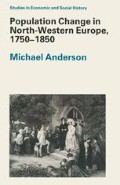Abstract
The previous section has shown that variations in birth rates were an important mechanism of demographic change. We can distinguish four factors which may help in understanding these variations: compositional effects, illegitimacy and pre-nuptial pregnancy, changes in marital fertility, and changes in marriage patterns.
Preview
Unable to display preview. Download preview PDF.
Author information
Authors and Affiliations
Copyright information
© 1988 The Economic History Society
About this chapter
Cite this chapter
Anderson, M. (1988). Fertility and Nuptiality. In: Population Change in North-Western Europe, 1750–1850. Studies in Economic and Social History. Palgrave, London. https://doi.org/10.1007/978-1-349-06558-5_6
Download citation
DOI: https://doi.org/10.1007/978-1-349-06558-5_6
Publisher Name: Palgrave, London
Print ISBN: 978-0-333-34386-9
Online ISBN: 978-1-349-06558-5
eBook Packages: Palgrave History CollectionHistory (R0)

